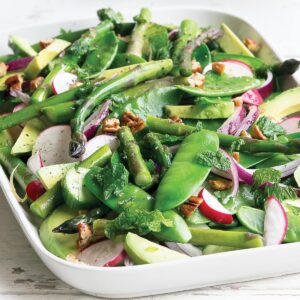
House prices might be holding them back, but your kids will move out eventually. Here’s how to make the change a positive one for both your weight and your well-being.
Young Kiwis are flying the coop later and later, thanks to a complex mix of financial, emotional and social factors. But when they do, it can be a challenge cooking for just one or two after feeding an adult family for years.
This life change often coincides with other risk factors for weight gain, so it makes sense to be aware of some of the ‘empty nester’ traps – and how to overcome them.
Trap 1
You cook to feed an army
When the kids are at home, you’re often making big family meals for drop-ins and plus-ones. “You might find it hard to stop cooking large volumes of food due to habit,” says dietitian Milly Smith. “That can lead to eating more because, with fewer mouths to feed, there’s more food available – food you don’t want to waste.”
The fix:
Halve recipes, or learn to cook in batches
Before you start cooking, scale the ingredients of your favourite recipes down to serve just one or two people.
If the recipe serves four and you’re cooking for two, halve the ingredient quantities. If you’re cooking for one, quarter the quantities.
“But, sometimes, it’s not economical to cook a smaller batch,” Ms Smith says, “and that’s fine. You can eat the leftovers the following day or divide them into single portions and freeze. The key is putting any extra serves away before you sit down to eat. Otherwise, you might be tempted to keep picking.”
Trap 2
You buy too much food
When you’re used to loading up your trolley to feed several people, it’s easy to go into autopilot as soon your hands close around that handlebar. “Not only can that lead to an oversupply of discretionary foods at home, you could also waste a lot of fresh food, if it spoils before you can eat it,” Ms Smith says. It’s time for some fresh thinking.
The fix:
Shop for your groceries online
Online food shopping has been shown to help decrease impulse purchases and lead to healthier choices, reducing the overall volume of food purchased as well as access to high-fat foods at home.
Another option is to take with you a shopping-for-one or shopping-for-two list. This helps you avoid putting things you don’t need into your trolley by reducing impulse purchases. It also makes it easier to remember what you came for.
Trap 3
You lose motivation to cook
“Finding the motivation to cook for just one or two people can be difficult,” Ms Smith says. “Plus, some parents miss the food-prep help their adult children once provided. Both circumstances make it easy to turn to less healthy choices such as takeaways.”
You might also be socialising more, which means more time spent at cafés and restaurants and less time at home cooking.
The fix:
Stock your pantry with healthy ‘fast’ foods Staples
such as canned beans or fish, ready-to-heat rice and dried pasta, last for ages and make healthy home cooking easy when you’re short on time or inspiration.
Canned fish and microwavable brown rice, paired with a bag of steamed veges and a splash of soy sauce, is a nutritious, fast meal. This is also where frozen leftovers are really handy.
Trap 4
Other big life changes are happening
With kids leaving home later than previous generations, other life changes often coincide with you becoming an empty nester – changes such as menopause and retirement, which are risk factors in themselves for unwanted weight gain.
The fix:
Make a commitment to daily exercise
It sounds obvious, but a UK study found men were 23 per cent less likely to meet physical activity guidelines around retirement and it’s not uncommon for women to halve the amount of exercise they engage in during menopause.
To encourage yourself to exercise more, start wearing an activity tracker.
People who do don’t always nail their fitness goals, but studies show they achieve significantly more weekly exercise and increase their daily step count. So, step to it.
Trap 5
You eat to feed emotions
While ‘empty nest syndrome’ has traditionally been linked to triggering feelings of loss, recent research paints a different picture for couples, finding that relationship satisfaction often improves once children leave home.
Sounds great, but happier marriages also bump up the likelihood of gaining weight, according to a 2013 study. And, if being home alone makes you feel lonely, that’s a risk factor for weight gain too. It can affect levels of an appetite-regulating hormone that makes you feel hungrier. Luckily, there’s something you can do in both cases.
The fix:
Keep a food diary, whether it’s paper or app-based
Regardless of which emotions might be influencing your food choices, logging what you eat can help keep your appetite and mindless eating under control.
How to shop and cook for one
These tips make sticking to a healthy diet simple and cost-effective for both singles and couples.
Save leftover ingredients
Rather than throwing away liquid stock, pasta sauce, legumes and canned fish when there’s too much for your single-serve meal, get creative. Freeze liquid ingredients and sauces in ice-cube trays and repurpose others.
For example, you can blitz leftover canned chickpeas into hummus, turn leftover canned tomatoes into a quick pasta sauce, use leftover legumes to bulk up a soup or stew and process canned salmon or tuna into homemade fish patties by adding some egg, flour and chopped veges.
Start or join a community cooking group
Talk to your neighbours, friends or family about meal sharing. This is where you take turns cooking big batches of food, dividing these batches into single-serve containers and delivering them to group members. You get to enjoy a wide variety of meals, without having to cook every night.
Pick a theme
Decide on a weekly theme, such as Mexican or Italian. You’ll get to taste and enjoy different cuisines, but still use up that packet of tacos or jar of pasta sauce.
Try new recipes
If you find your interest in cooking for yourself is starting to wane, committing to cooking a new recipe once a week will help you stay motivated.
Use our Single serve or Meals for one & two recipe collections
Get started with our delicious meals that serve one or two.
Stock up on frozen vegetables
They’re just as nutritious as fresh varieties, won’t go off and are often cheaper, too. They’re also cut, so it’s quick and easy to prepare a single-serve vege portion to add to your meal.
Downsize your purchases
As your household gets smaller, your packet sizes can follow suit. You might find you only need a litre of milk, not two, or half-a-dozen eggs instead of 12. The bonus? Your grocery bill will downsize too.
Adopt once weekly ‘clean out the fridge’ meals
Your kids no longer come home ravenous and lay siege to the fridge, so dedicate a night each week to eating leftovers to stop them going in the bin.
Article sources and references
- Allender S et al. 2008. Lifechange events and participation in physical activity: A systematic review. Health Promotion International 23:160-72https://www.ncbi.nlm.nih.gov/pubmed/18364364
- Au N et al. 2013. The costeffectiveness of shopping to a predetermined grocery list to reduce overweight and obesity. Nutrition & Diabetes 24:e77https://www.ncbi.nlm.nih.gov/pubmed/23797384
- Burke LE et al. 2011. Selfmonitoring in weight loss: a systematic review of the literature. Journal of the American Dietetic Association 111:92-102https://www.ncbi.nlm.nih.gov/pubmed/21185970
- Burn K & Szoeke C. 2016. Boomerang families and failureto- launch: Commentary on adult children living at home. The European Menopause Journal 83:9-12https://www.ncbi.nlm.nih.gov/pubmed/26597141
- Cadmus-Bertram LA et al. 2015. Randomized trial of a Fitbit-based physical activity intervention for women. American Journal of Preventative Medicine 49:414-8https://www.ncbi.nlm.nih.gov/pubmed/26071863
- Chung S et al. 2009. The effect of retirement on weight. Journal of Gerontology Series B 64:656-5https://academic.oup.com/psychsocgerontology/article/64B/5/656/540520
- Forman-Hoffman VL et al. 2008. Retirement and weight changes among men and women in the health and retirement study. Journal of Gerontology B. Psychological Sciences and Social Sciences 63:S146-53https://www.ncbi.nlm.nih.gov/pubmed/18559689
- Gorchoff SM et al. 2008. Contextualizing change in marital satisfaction during middle age: An 18-year longitudinal study. Psychological Science 19:1194-200https://www.ncbi.nlm.nih.gov/pubmed/19076493
- Gorin AA et al. 2007. Home grocery delivery improves the household food environments of behavioral weight loss participants: Results of an 8-week pilot study. International Journal of Behavioral Nutrition and Physical Activity 14:58https://ijbnpa.biomedcentral.com/articles/10.1186/1479-5868-4-58
- Jaremka LM et al. 2015. Loneliness predicts postprandial ghrelin and hunger in women. Hormones and Behavior 70:57-63https://www.ncbi.nlm.nih.gov/pubmed/25725426
- Meltzer AL et al. 2013. Marital satisfaction predicts weight gain in early marriage. Health Psychology 32:824-7https://www.ncbi.nlm.nih.gov/pubmed/23477578
- Proietto J. 2017. Obesity and weight management at menopause. Australian Family Physician 46:368-70https://www.ncbi.nlm.nih.gov/pubmed/28609591
- Rollings KA & Wells NM. 2017. Effects of floor plan openness on eating behaviours. Environment and Behaviour 49:663-84https://journals.sagepub.com/doi/abs/10.1177/0013916516661822
www.healthyfood.com










